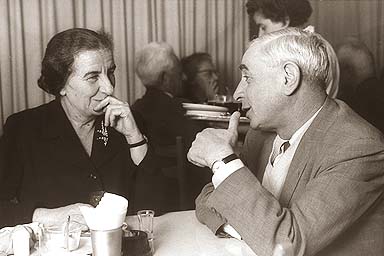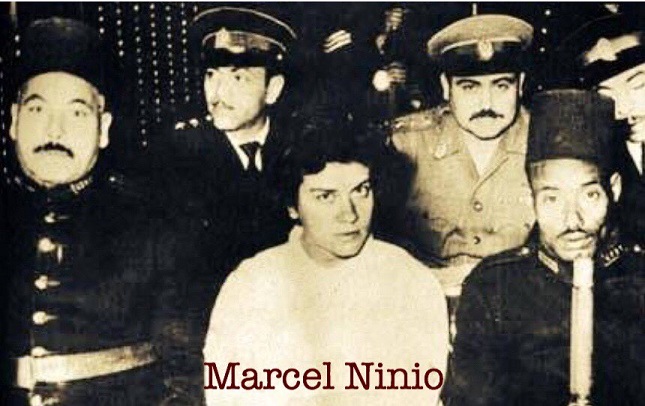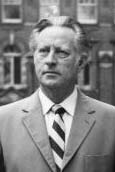
hatching state sponsored terrorism in the region: Golda Meir, Pinhas Lavon

Marcelle Ninio arrested
|
|
|
|
|
|
EGY.COM - JUDAICA
|
|
by Samir Raafat
Egyptian Mail, August 3, 1996


Marcelle Ninio arrested
Following the November 1995 attack on a US Army base in Riyadh and the Hamas bus bombings in Israel, 1996 will be remembered as the year of anti-terrorism.
To begin with there was the March 1996 Sharm al-Sheik anti-terrorism summit which brought together world leaders in an unprecedented conclave. Then there was the July security conference in Cairo which attempted to define terrorism, followed by an August G7+1 ministerial conference in Paris on how to combat terrorism.
Asif to underline his concern of the growing plague recently punctuated by the June 1996 Khobar Towers bombing which killed 19 American airmen in Dahran, President Clinton's White House declarations during his July 30 joint press conference with Egypt's President Mubarak, focused primarily on terrorism.
Terrorism today denotes a range of "antiestablishment" actions. From violent objector, freedom fighter and guerilla, to insurgent, spymaster, separatist Vietcong, fedayeen and Black Panther. Some observers will throw in such movements as ETA, IRA, PKK, Shining Path and Hamas.
Saboteurs' and agents provocateurs a la Guevara and Carlos the Jackal, once romanticized in le Carre and Robert Ludlum novels, are things of the past. Yet remove 007's Waspish good looks, fancy cars and top models, and what you get is modern state-sanctioned terrorist.
THE VIRTUOUS DAYS : Marcelle Ninio: FREEDOM-FIGHTER or TERRORIST?
Ms. Victorine Marcelle Ninio (which she spelt Nigno) was a native of Cairo and a one-time Olympic contender who played basketball at the Hakoah Club on Selahar Street, Heliopolis. The combination of geopolitics, youth and personal ideals pushed her into the forefront of regional events in July 1954.
Although born and raised in Egypt, Ninio threw her with the newly created State of Israel. And if in 1948 she suspected her actions could be catalytic to the downfall of Egypt's thriving Jewish community, by the time she faced sentence in 1955 she had no lingering doubts.
No doubt Ninio and her associates were indirectly responsible for the hastening of 50,000 Jews out of Egypt. Yet on a more personal tragic note, Armando Carmona, a close companion of Nino's family, allegedly took his own life (or was encouraged to) upon discovering his Heliopolis flatmate had been indicted in a covert Israeli-led operation.
The physically challenged Carmona (walking disability problem) worked for the The Cairo Electric Railways & Heliopolis Oases Company known to most simply as The Heliopolis Company. After working hours it was his habit to join his friends at the nearby Heliopolis Sporting Club for a round of cards. Failing to appear one day, his anxious partners advised the police. Upon entering his flat at 6 Rue Ibis off Avenue des Pyramides, Armando was found hanging from the ceiling. To this day, Marcelle Carmona-Fisher, who lives outside Tel Aviv, failed to resolve the riddle of her father's death. Her attempts to obtain answers from the Israeli government have been persistently stonewalled.
As it turned out during the Cairo investigation, Armando's friend, Marcelle Ninio, was part of an espionage network run by the Israeli military. Their objective: To spread havoc in Cairo and Alexandria by planting bombs in crowded public areas such as cinema theaters, the main railway stations and central post office in both cities. And to discredit Egypt's image in the West, American USIS libraries and British Councils in both cities were also added as an afterthought.
In other words, Marcelle Ninio and her colleagues were licensed to kill. Never mind that their firebombs annihilated innocent civillans.
Ninio's ultimate controllers were senior Israeli officers including Binyamin Givli of Military Intelligence. They had laid out the game plan. Also in the know were privileged members of the political Israeli apparatus including cabinet members-to-be like Shimon Peres, Moshe Dayan and Ben-Gurion (then in retirement). The code name for this mission of death was Operation Shoshana (Susana) known in history books as the Lavon Affair or Esek Bish (the Mishap).
A latter day name for this deadly operation was Ha-Parashah (the case).
Consonant with the multiple names associated with this operation, the overall objective went beyond destabilizing Egypt's new republican regime and causing dissension in Egypto-British/US relations. Aside from forestalling the withdrawal of British troops from the Canal Zone, its success or failure notwithstanding, another equally important objective of this operation was to poison relations between mainstream Egyptians and the 50,000 Jews who had remained in Egypt after the 1948 Arab-Israeli war.
Operations similar to Shoshana had been primed elsewhere in the Middle East where large Jewish communities existed. The most important of which little is known even today took place in the early 1950s in the British-controlled Hashemite Kingdom of Iraq.
It was in Iraq that Israeli agents went after American (US Library) and Jewish targets wounding and killing innocent bystanders near Baghdad's Shemtof Synagogue. Predictably, requests for exit visas started pouring in and within a year, Iraq's largest and most important non-Moslem community --over 120,000 Jews-- relocated in Israel.
No doubt the success of Operation Ali Baba in Iraq prompted Israel's policy-makers to replicate its double in Egypt.
Had Israel bosses waited a few more years rather than resort to state-sponsored terrorism, Egypt's Jews would have left by their own free will, just like Egypt's Italian, Greek, Armenian and Syro-Levantine minorities, all of whom found the emerging combination of nationalism and state-controlled economy distasteful.
Ever since the days of Viceroy Mohammed Ali Pasha, (r.1805-48), laissez faire and free enterprise had been the mainstay of the nation's minorities. Lacking those elements, which had attracted foreigners to Egypt, why would the above minorities remain? Moreover, with the arrival of socialism in July 1961 it was the turn for Moslem and Coptic members of Egypt's business class to apply for immigrant visas, an unprecedented phenomena in a country that had accepted economic migrants for four thousand years.
Operation Shoshana -- a.k.a. Susana, Lavon, the Mishap, the Affair (take your pick) failed in the summer of 1954 because Paul Frank (alias Avraham Siedenwerg or Avri El Ad), one of the 13 Israeli agents involved, had had second thoughts.
An undecided Zionist, Frank snitched to an Egyptian undercover agent in Germany. By so doing he not only spared innocent lives, but also brought down the government of Moshe Sharett in Israel, starting with the February 1955 resignation of Defense Minister Pinchas Lavon.
Like so many disturbing facts that characterized Israel's first 50 years, Operation Shoshana was buried and forgotten by official propagandists. In fact when its perpetrators were rounded up in Cairo no one from Israel stepped forward to take responsibility of their failed operation. And if mentioned at all Ninio and her accomplices were sensitively referred to as saboteurs (never as terrorists) by the western press.
Diverse court verdicts were delivered on 27 January 1955, ranging from two death sentences to several years in prison, some of them in absentia.
Predictably the Cairo rulings sent Israel into an unofficial state of mourning. There were emotional promises to dedicate a street in Ramat Gan and Beersheeba each in honor of the fallen "victims", an action which would have its equivalent today in renaming one of Gaza's streets in commemoration of a Tel Aviv suicide bus bomber.
Marcelle Ninio and three of her colleagues were released during the 1967 June War prisoner exchanges. No one knew she had returned to Israel. In her country of adoption like in her country of birth Ninio was a source of political embarrassment. The situation changed only after Prime Minister Golda Meir personally announced in 1974, she would attend Ninio's wedding. That year, what had been deliberately ignored for so long, came out on Israel's national TV. Operation Shoshana was no longer a carefully guarded state secret.
How ironic that throughout the polemic the word 'terrorism' was never once brought up. With the help of seasoned spin-doctors and with the assistance of an immensely powerful Jewish lobby in the United Sates, the terms 'agents' or 'saboteurs' were used instead.
Equally remarkable in this whole affair is how one of the first prototype of organized state sponsored terrorism in the region was shrouded under tons of secrecy acts and waves of disinformation campaigns.
The usually merciless and overzealous media never insisted. Referring the story, then and later, the New York Times slanted the story and witheld the facts.
The Israeli state apparatus did not realize then that one day the chicken would come home to roost. This time against civilians in Tel-Aviv buses.
Notes:

Subject: The Lavon affair
Kobi Haron
Fri, 13 Apr 2007 23:08:44 +0300
I found your article about Marcelle Ninio. I am not an expert on this, but I would like to correct some of the misconceptions I found in your treatment of this sordid affair.
Some of the more important documents that relate to "The Affair" have yet to be published. However, the current view is that some of the villains in your story weren't implicated in the mishap. These days very few blame Ben Gurion, Sharet, Golda Meir and Shimon Peres for anything related to "The Affair". Lavon apparently wasn't implicated either. This is still contentious, but there is strong evidence that Gibli had tried to forge evidence to show that he got instructions from Lavon to start the sabotage in Egypt. It was apparently Gibli who masterminded the whole thing. The role of Moshe Dayan is not well understood. He was at the time the army chief of staff and Gibli's superior, but he managed to distance himself from this fiasco and he was not mentioned as somebody who should account for it.
I don't know about evidence that the bombings were intended to haste Jewish immigration from Egypt.
Gibli who is still alive, has never agreed to be interviewed about The Affair. It is said that his memoirs will be published after his death. His reputation is such that few people are ready to rely on him for anything related to the affair. See the Wikipedia article - I am not qualified to evaluate it.
Your tone is such that I will not argue about state terrorism etc.
© Copyright Samir Raafat
Any commercial use of the data and/or content is prohibited
reproduction of photos from this website strictly forbidden
touts droits reserves